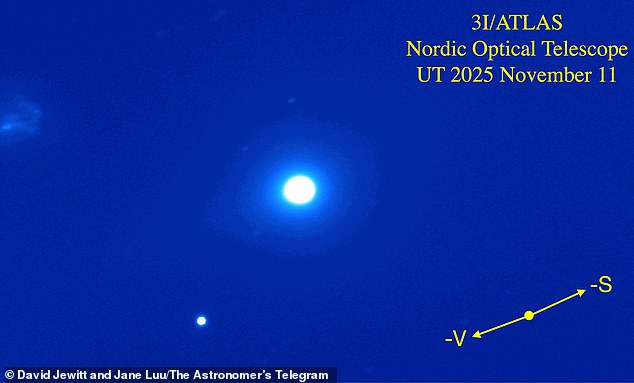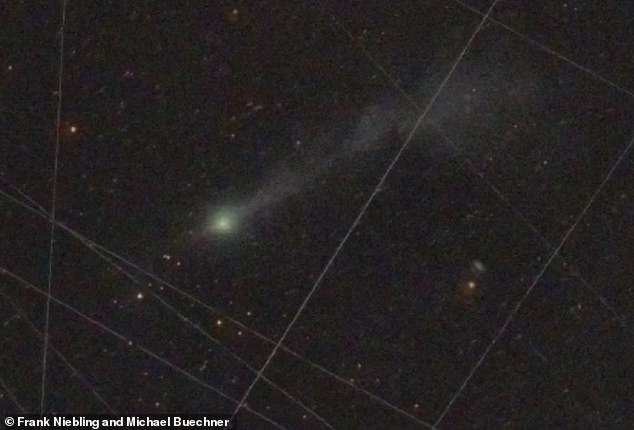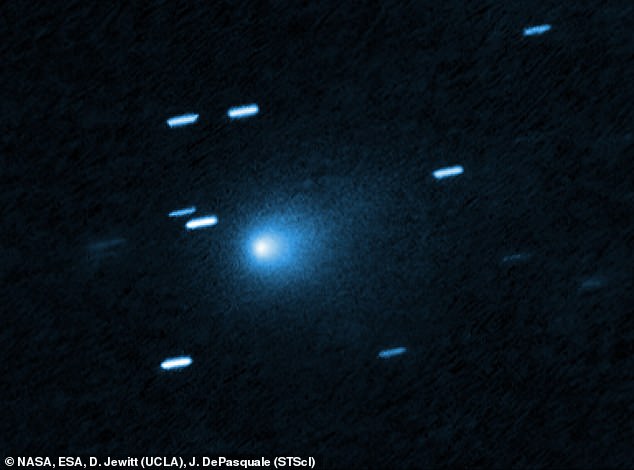The interstellar visitor blazing through our solar system shows startling signs that it may not be a comet, but something truly alien.
The object known as 3I/ATLAS recently survived a scorching flyby of the Sun completely intact, something no natural comet should be able to do.
Harvard professor Avi Loeb had said that humans would learn the truth about the visitor’s origins after it reached its closest point to the sun on October 29, where 3I/ATLAS should have begun to melt and a huge cloud of dust form around it.
However, the latest data has revealed that 3I/ATLAS is still a single, bright object with no pieces breaking off and no cloud of fragments or debris, further supporting Loeb’s theory that the object could be an alien mothership maneuvering around the sun.
Instead of a shattered mess, astronomers David Jewitt and Jane Luu found an intact body surrounded by a glowing coma, the fuzzy envelope of gas that is stretched out in two directions, one pointing toward the sun and another pointing away from it
The new images captured by the Nordic Optical Telescope in Spain also revealed that 3I/ATLAS still has a mysterious ‘anti-tail’ pointing toward the sun, despite the object now moving away from our home star.
A comet’s tail is a trail of dust and debris behind space rocks as they’re blasted by sunlight and solar wind, but an anti-tail strangely points this debris at the sun, although scientists have argued this could be an optical illusion.
However, the new photos taken on Tuesday also spotted two giant jet-like streams blasting out for hundreds of thousands of miles from the object’s surface, which defy the laws of science.

New images of 3I/ATLAS taken by the Nordic Optical Telescope in Spain have just been released and show the alleged comet has not broken apart

3I/ATLAS has also developed an anti-tail point toward the sun and two massive jets shooting material out into space
One has been shooting material out into space in the direction of the sun, while the other is nearly three times as long and appears to be pointing in the opposite direction.
Based on the size of 3I/ATLAS, which is roughly 3.5 miles across, Harvard professor Avi Loeb has said these jets can’t be naturally explained as water vapor pouring out of the comet because there isn’t enough ice there to produce such massive streams.
‘Technological thrusters which point their exhaust towards the sun would accelerate away from the Sun,’ Loeb said in a statement.
‘This post-perihelion maneuver might be employed by a spacecraft that aims to gain speed rather than slow down through the gravitational assist from the sun.’
Loeb’s theory that 3I/ATLAS has a technological origin has been met with scrutiny by many in the scientific community.
Astronomers throughout the world have maintained since its discovery in July that the object is a comet with an unusual chemical makeup from a distant solar system that formed under conditions far different from our own.
This includes shooting out streams of frozen carbon dioxide (CO₂) instead of normal water vapor, like comets that formed within our solar system.
However, the images revealed that the unexplained jet pointing toward the sun is 620,000 miles long, while the stream facing away from the sun is 1.86 million miles in length.

3I/ATLAS passed the sun on October 29, but new images show it has remained in one piece, which is unusual for a comet

Optical images captured on November 9 (pictured) reveal that 3I/ATLAS is ejecting enormous jets of material both toward and away from the sun
The presence of those giant jets means 3I/ATLAS was spitting out an enormous amount of material as it passed the sun in late October and early November, roughly five billion tons per month.
For a natural comet to release that much gas and dust, it would need a huge amount of ice being vaporized by the sun’s heat, and the three-mile-long 3I/ATLAS simply isn’t that large.
Loeb calculated the supposed comet would have needed an icy surface at least 14 miles across if it was composed of CO₂ ice and a staggering 32 miles across if 3I/ATLAS was venting water ice into space.
‘This raises a new anomaly of 3I/ATLAS that must be explained by those who wish to shove the anomalies of 3I/ATLAS under the carpet of traditional knowledge on solar system comets rather than consider alternatives,’ Loeb explained.
On Wednesday, Florida congresswoman Anna Paulina Luna, who chairs the House Oversight Committee investigating reports of UFOs and extraterrestrials, said some information gathered on 3I/ATLAS was still being withheld from the public.
Luna revealed that she was denied access to classified information on the interstellar object by the Pentagon, and also alleged that members of the US intelligence community were actively blocking the truth of 3I/ATLAS from being released.
‘I do believe it’s a passing through comet, and so I don’t think we are going to have any contact with any non-human intelligence yet, but the ruling is still out there on what this is,’ the congresswoman told NewsMax.

3I/ATLAS is expected to make its closest approach to Earth on December 19
NASA administrator Sean Duffy has also pushed back on the speculation that 3I/ATLAS is a spacecraft, calling any theories that the object contains alien life or will collide with Earth ‘not true.’
Despite the pushback, Luna has continued to call on NASA to release all of the images they’ve collected during the interstellar visitor’s journey through the solar system, including its close passes by Venus, Mars, and the sun.
She’s also publicly supported Loeb’s investigation into 3I/ATLAS, which has now found at least 11 anomalies that scientists have yet to fully explain, including its anti-tail, turning blue as it neared the sun, and sudden course changes that defy gravity.
While one strange oddity being seen in a comet could be explained by science, Loeb previously told the Daily Mail that the odds of 3I/ATLAS displaying all these anomalies at the same time were astronomical and point to it being an extraterrestrial craft.
